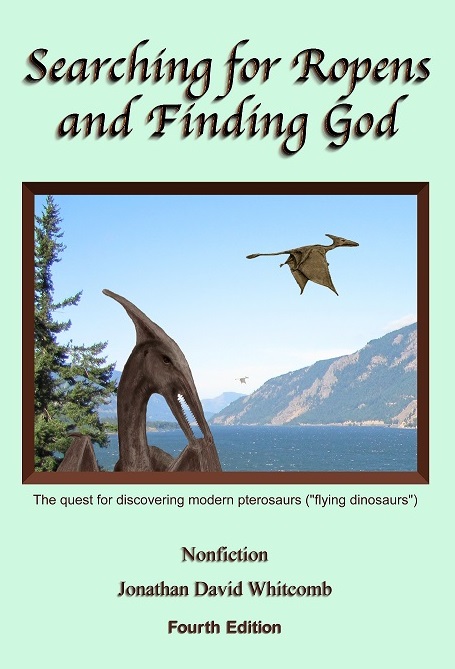The spiritual/true-life adventure/cryptozoology book Searching for Ropens and Finding God is now in its fourth edition. The following are some excerpts from this nonfiction paperback book:
From the Title Page:
This overshadows common true-life adventures, revealing the early stages of what may become the most unsettling scientific discovery since Galileo and Copernicus. It soars above disputes about religion, revealing why an official discovery of an extraordinary animal was delayed for so long. Above all, this explores human experiences—of eyewitnesses and those who interviewed them. People have become connected by common encounters: Persons of various faiths, with various levels of education, from various countries and cultures, have seen a living pterosaur.
From the Introduction:
Expect answers in this book: why my associates and I traveled to a remote tropical island to search for living pterosaurs and why only a few professors have given us any hope that they still live. What about adventures, with danger, failure, and success? Yes, expect those, but I hope my readers will discover more than adventure—a purpose in life—as worthy a purpose as I have found. This is no instruction manual for finding God, yet I suggest that the spiritual quest gives us the highest reward.
From the first paragraph of the first chapter:
It looked like a dead pterodactyl; not fossil bones but with skin, like it had died recently. Could those creatures, non-extinct, still fly? Although I could not verify the photo was genuine, the idea within that image in a soon-forgotten book would be awakened four decades later, to plunge me into the most dramatic adventure of my life: exploring a remote tropical island, searching for giant living pterosaurs.
From the third chapter:
“. . . in 1944 . . . I was stationed in Finschhafen, New Guinea, with the U.S. military. While there, I made several trips into some of the surrounding native villages with a friend of mine and a native guide (provided by the Australian government). On this one particular trip, we had the wonderful opportunity to witness a pterodactyl take off from the ground and then circle back overhead and to the side, giving us a perfect side view which clearly showed the long beak and appendage protruding from the back of its head . . .
From the twenty-second chapter:
The sighting of a glowing “dragon” in England, around 1987, could be dismissed, for it was just a ten-year-old girl watching the stars, and that’s just one story. The two sightings of huge glowing flying creatures in the San Fernando Valley could be dismissed, for they were near Hollywood (the land of fictional creations), and that’s just two stories. The glowing creatures flying in the Caribbean could be dismissed, for they appear like nothing in any biology textbook, and that’s just two sightings. But scan the landscape of sighting reports and see what few other humans have seen for the past two centuries: Trees connected by underground roots, revealing the edge of a forest. How many eyewitnesses there must be who never contacted me about appearances of glowing flying creatures!
.
Front cover of the nonfiction cryptozoology book by Jonathan David Whitcomb




One Reply to “Nonfiction book on modern pterosaurs”
Comments are closed.